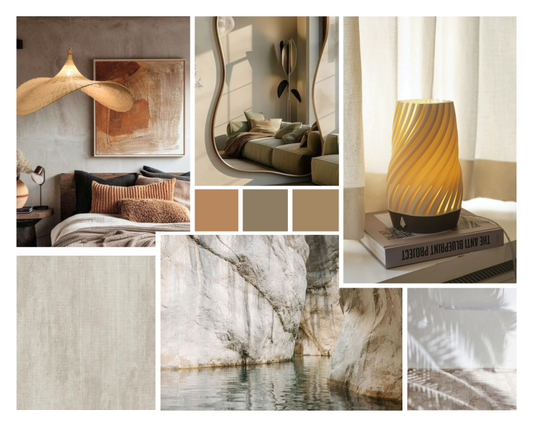Japandi: The Fusion of Japanese Zen and Scandinavian Simplicity
In the world of interior design, a new style is gaining increasing attention: Japandi. This unique aesthetic blends the best of two worlds—the calm simplicity of Japanese design and the functional elegance of Scandinavian design. The result is an interior style that elevates minimalism to an art form, with a focus on tranquility, serenity, and natural materials.
What is Japandi?
Japandi is a fusion of 'Japanese' and 'Scandi,' and as the name suggests, it combines the characteristics of both cultures. It’s a harmonious blend that merges the warm, inviting atmosphere of Scandinavian interiors with the zen-like, minimalist aesthetic of Japanese designs. This style emphasizes functionality, simplicity, and the creation of a calm, serene living environment.
Differences Between Japandi and Scandinavian Design
While Japandi shares many elements with Scandinavian design, there are some key differences that set it apart and make it unique.
1. Inspiration and Influences
Scandinavian design is rooted in the nature of Northern Europe and emphasizes functional, simple designs that exude warmth and coziness. Japandi adds a Japanese dimension, centered around the concept of wabi-sabi. This leads to an even more stripped-down, minimalist approach, where imperfection and simplicity are embraced.
2. Color Palette
One of the most noticeable differences between Japandi and Scandinavian design is the color palette. Scandinavian design often features light, cool colors like white, light gray, and pastels. In contrast, Japandi opts for a deeper, earthier palette. Warm wood tones, soft grays, and muted, natural colors dominate this style, creating a calm, zen-like atmosphere.
3. Materials and Textures
Scandinavian design frequently uses light woods, woolen blankets, and natural fabrics to create a sense of warmth and coziness. Japandi combines these elements with refined materials such as bamboo, ceramics, and paper. These materials not only nod to Japanese traditions but also add an extra layer of texture and sophistication to the interior.
4. Decor and Details
In Scandinavian design, functionality is paramount, with interiors that are primarily practical and contain few decorative items. Japandi adopts this minimalist approach but incorporates subtle Japanese elements, such as traditional art and zen-inspired accessories. These details introduce a sense of tranquility and contemplation into the space.
How to Incorporate Japandi into Your Own Interior
If you're inspired by the Japandi style and want to bring it into your own home, here are a few tips to help you get started:
Choose a Neutral Color Palette: Start with a base of neutral, earthy tones like beige, gray, and warm wood shades. Add depth with muted colors such as olive green or deep blue.
Use Natural Materials: Invest in furniture and accessories made from natural materials like wood, bamboo, ceramics, and linen. These materials bring the tranquility of nature into your home.
Keep It Minimalistic: In Japandi, less is more. Avoid unnecessary decorations and instead opt for a few carefully chosen pieces that are both functional and aesthetically pleasing.
Incorporate Japanese Accents: Introduce subtle Japanese elements into your interior, such as a traditional teapot or a (bonsai) tree. These items contribute to the zen-like atmosphere of Japandi.
Create Space for Tranquility: Ensure that your interior exudes a sense of space and calm. Avoid clutter and choose storage solutions that keep the area clean and organized.
The Importance of Airy Spaces
In Japandi design, it's essential to keep spaces open and airy. This not only promotes a sense of tranquility but also ensures that each element in the room can stand out without being overshadowed.
Japandi: The Style That Balances East and West
Japandi is more than just a design trend; it's a lifestyle that embraces simplicity, functionality, and calm. By blending the Scandinavian focus on comfort and coziness with the Japanese emphasis on minimalism and zen, Japandi creates a harmonious environment that is both aesthetically pleasing and functional. Whether you're looking to completely overhaul your interior or simply want to incorporate a few elements of this style, Japandi offers the perfect balance between Eastern and Western influences.
More tips?
View all-

Een eye-catcher in je interieur
A striking pendant lamp instantly elevates your living room to the next level. With the right colors, materials and placement, such a lamp becomes not just a light source but...
Een eye-catcher in je interieur
A striking pendant lamp instantly elevates your living room to the next level. With the right colors, materials and placement, such a lamp becomes not just a light source but...
-

Sustainable Lighting: Recycled and Biobased
In this series, we invite you to take a behind-the-scenes look at Noord See Lights. We'll show you how our lamps are crafted and the materials we use. Sustainability and...
Sustainable Lighting: Recycled and Biobased
In this series, we invite you to take a behind-the-scenes look at Noord See Lights. We'll show you how our lamps are crafted and the materials we use. Sustainability and...
-

Creating a Moodboard
A strong interior design starts with a clear understanding of your personal style and preferences. A moodboard helps you define your direction and ensures your interior feels cohesive. In this...
Creating a Moodboard
A strong interior design starts with a clear understanding of your personal style and preferences. A moodboard helps you define your direction and ensures your interior feels cohesive. In this...









